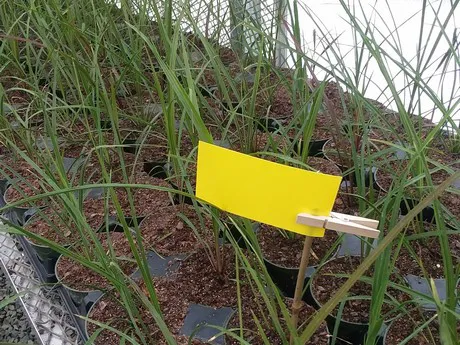In the past week thrips were observed on several crops including spikes (Dracaena), Vinca, tomato and chrysanthemum.
by Angela Madeiras and Jason Lanier
Monitoring for thrips begins with the arrival of cuttings, as most thrips infestations start with insects that come in on plugs and cuttings. A sound dipping program, therefore, is the first line of defense and can lay the foundation for successful biological control later. Possible dip materials range from oil-based, to soaps, to biological control agents (BCAs), with recent research suggesting that oil-based dips are particularly effective for thrips. Be sure to refer to the product label for proper rates and safety of dip materials for specific crops.

Thrips monitoring on Dracaena. Photo by Jim Mussoni
Biological control of thrips needs to start early in the season before the pest becomes abundant. Several biocontrol agents are used to control thrips; best results are achieved when they are used together. Beneficial nematodes are effective against thrips pupae in the soil, but will not control nymph or adult stages. Neoseiulus cucumeris mites prey only on first instar nymphs, and Amblyseius swirskii mites will eat first and second instar nymphs; both species will also eat eggs. Orius insidiosus (minute pirate bug) is the only biological control agent that preys on adult thrips.

Thrips monitoring on Vinca. Photo by Jim Mussoni
When using conventional pesticides for thrips management, be sure to rotate active ingredients as thrips populations are highly susceptible to resistance development. Consult company side-effects literature for compatibility of pesticides and biocontrol agents.
For information on organic and conventional products for thrips management on greenhouse crops consult the New England Greenhouse Floriculture Guide: https://www.negreenhouse.org/pest-guides.html
Source: UMassAmherst
